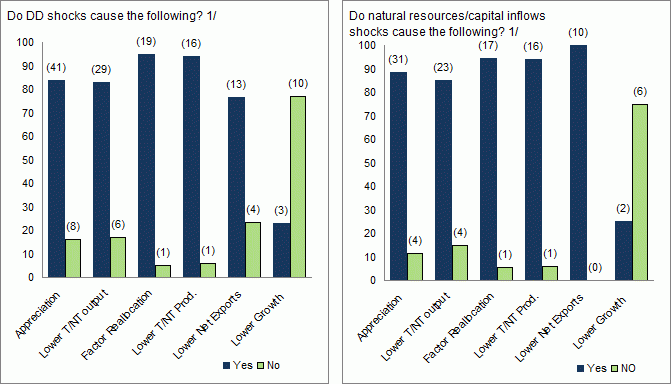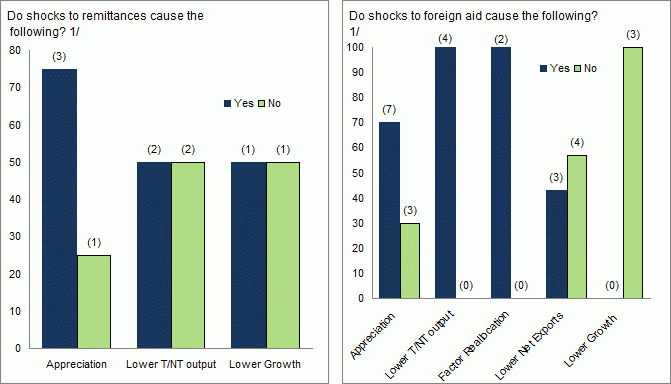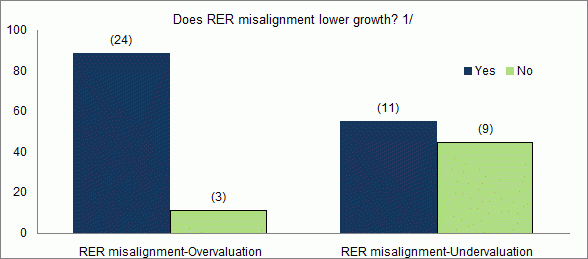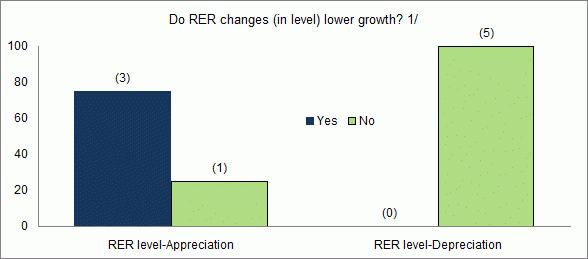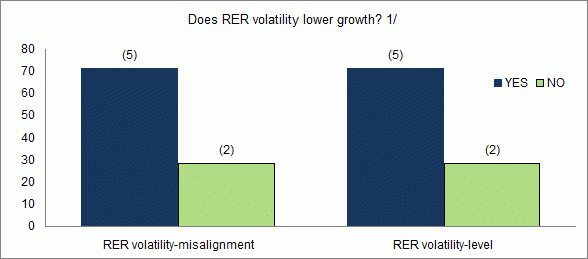In the aftermath of the recent financial crisis, interest-rate differentials have triggered a surge in capital inflows to many emerging market countries. Meanwhile, strong growth of several emerging market countries, especially in Asia, will likely continue to support commodity prices. While this benign external environment brings opportunities, it also raises some risks and challenges. Capital inflows and higher commodity export prices exert appreciating pressures on the exchange rate, which poses a policy challenge in many countries. The concern is that a stronger currency could undermine the competitiveness of their tradable sectors and weaken growth.
In the 1960s the Netherlands discovered natural gas in the North Sea, increasing the country’s wealth. On the back of the latter, the increase in the price of this commodity acted as a further wealth effect, increasing domestic aggregate demand. However, as the Netherlands is a small open economy, the price of tradable goods was given. Since the price of non-tradable goods clears in the domestic market, higher domestic demand thus increased the relative price of non-tradable goods. The Dutch guilder appreciated in real terms, decreasing the country’s competitiveness, in turn reducing the other tradable industries’ exports. Since then, this type of phenomenon (which could also be triggered by an exogenous increase in the price of a country’s existing export, or an increase in capital inflows, foreign aid, or remittances) has been labelled “Dutch disease” (see The Economist 1977 and early contributions from Corden 1981, 1984, Corden and Neary 1982, Krugman 1987, and Van Wijnbergen 1984).
While a natural resource boom (or any other shock entailing an increase in foreign exchange inflows) is in principle a positive development due to wealth effects, there have long been concerns among economists about the potential negative impact of Dutch disease on long-term growth (see for example Rajan and Subramanian 2005 and Ismail 2010). These concerns are usually based on the idea that the declining (usually manufacturing) tradable sectors may possess some special characteristics that would stimulate growth and welfare in the long term (such as increasing returns to scale, learning by doing, spillover effects, or other positive externalities).
Motivated by the experiences of China and other east Asian countries, a new literature based on the export-led growth strategy states that maintaining an undervalued or “competitive” real exchange rate may foster economic growth – where the operative channel is the size of the (manufacturing) tradable sector. In this view, while real exchange-rate overvaluations hurt growth, undervaluations foster it. This contrasts with another position, which argues that any real exchange-rate misalignment from its long-run (fundamentals’ based) equilibrium will lower growth – regardless of whether it is over- or under-valuation (Berg and Miao 2010).
However, to show that Dutch disease reduces growth needs a strong assumption that the manufacturing tradable sector is somehow “special”. Mostly, learning by doing or other types of externalities in this sector have been assumed to obtain theoretical models linking Dutch disease with lower growth. Absent these assumptions, Dutch disease only depicts an equilibrium real exchange-rate appreciation reflecting stronger fundamentals and de-industrialisation, but would not necessarily be bad for overall growth.
A review of Dutch disease
In recent research (Magud and Sosa 2010), we examine whether the literature provides strong support for concerns about the potential adverse effects of the Dutch disease on long-term growth. To this end, we review over 60 papers on Dutch disease and on the relationship between the real exchange-rate and growth. To make systematic comparisons of the papers’ results, we construct simple indices to evaluate their partial and overall implications. In turn, the latter evidence is used to analyse the policy implications of Dutch-disease shocks.
We document that Dutch disease does exist. Shocks that trigger foreign exchange inflows (such as natural resource booms, surges in capital inflows, foreign aid, remittances, etc.) lead to an appreciation of the real exchange rate, generate factor reallocation, and reduce manufacturing output and net exports. However, crucially, we do not find evidence that Dutch disease reduces economic growth. We also find that real exchange-rate misalignment – in particular when due to overvaluation – and higher volatility of the real exchange rate lower growth. Regarding the effect of undervaluation of the exchange rate on economic growth, the evidence is mixed and inconclusive. The figures below summarise the results.
Figure 1. Literature review in numbers: Dutch disease
Source: Authors' calculations.
Note: 1/ Inpercent of total observations. Number of observations in parenthesis.
Figure 2. Literature review in numbers: Real exchange rate and growth
Source: Authors' calculations.
Note: 1/ In percent of total observations. Number of observations in parenthesis.
Most of the Dutch disease empirical literature focuses on the impact of foreign exchange inflows (natural resource booms, remittances, aid, etc.) on the real exchange rate and the reallocation of resources between the tradable and non-tradable sectors but does not examine the effects on long-term growth and does not analyse whether the adverse effects associated to Dutch disease offset the beneficial effects of inflows. Research in this area has typically not attempted to directly demonstrate the presence of spillovers or other growth-enhancing qualities in the tradable sector. Hence, the evidence on the negative impact of Dutch disease on growth is still partial, and generally inconclusive.
Concerns about Dutch disease may also derive from the view that real exchange rate overvaluation lowers growth, a result that appears to be supported by the empirical evidence. Evidence on the positive effects that an undervalued real exchange rate may exert growth is mixed, with some studies suggesting that undervaluation actually hurts growth. In any case, the real exchange rate appreciation associated with Dutch disease is in principle an equilibrium phenomenon that reflects a change in underlying fundamentals and not necessarily implies overvaluation, so it is not clear why lower growth should be an unavoidable outcome.
Therefore, even though there is some debate onto whether misalignment or overvaluation lowers growth, the channel through which Dutch disease reduces economic growth is not found in the literature. This is quite relevant, as it affects the economic policy discussion.
Should real exchange-rate appreciation be a source of concern for policymakers? Should they act to curb Dutch disease effects? If yes, is it due to concerns about long-run growth? What is policy really capable of doing? A given appreciation of the real exchange rate may have a differential impact on economic growth depending on whether or not it reflects an equilibrium phenomenon. If the appreciation is driven by a permanent change, then it will imply a long-run equilibrium movement, and in principle Dutch disease should not be a concern. However, the real exchange rate could overshoot and become overvalued (for instance, if agents overestimate the persistence of the shock, or in case an excess supply of money results from the government’s monetisation of the external shock – which triggers an overshooting of the price of non-tradable goods). Thus, macroeconomic policy should focus on avoiding overshooting, overheating, and the surge of macroeconomic imbalances that could later become unsustainable.
It is sometimes very difficult for policymakers to assess if a certain shock and the corresponding real exchange-rate appreciation will be temporary or permanent. If the authorities treat a permanent shock as temporary and decide for example to intervene in the foreign exchange market, they will delay an unavoidable – and desirable – macroeconomic adjustment, incurring also in substantial quasi-fiscal costs due to sterilisation. If, on the contrary, they treat a temporary shock as permanent, they may experience costs in terms of reduced growth. The optimal policy response would depend, to some extent, on the type of shock behind the Dutch disease. For instance, in case of a surge in aid inflows, the creation of a sovereign wealth fund to be held abroad would not make sense.
Fiscal policy is a natural instrument to help curb Dutch disease effects. In fact, excessive public spending has been a common component of economic mismanagement of booms stemming from positive Dutch disease shocks. Fiscal policy may play a role not only by mitigating the “spending effect” associated with Dutch disease but also by smoothing expenditures to reduce output volatility.
A prudent expenditure policy would help saving part of the increased revenues, which could be used to either repay external debt or accumulating foreign assets. This would help to limit aggregate demand pressures and hence the spending effect, and weaken real appreciation pressures. Directing spending to tradables (e.g., imported capital goods) would also help curbing the negative impacts of Dutch disease. If there is a presumption that the shock may be temporary, smoothing expenditure over time would help to reduce volatility. In this case, a fiscal rule and the use of a stabilisation fund could be appropriate.
There is also a case for improving the quality of expenditures, for example by promoting investments that would entail positive supply-side effects. Investments that foster productivity and supply of nontradables (such as investments in infrastructure, education or other activities to improve and expand the availability of skilled labour) would be particularly advantageous.
Finally, improving financial regulation and supervision could play an important role in helping to contain credit booms or assets bubbles, reducing the likelihood of boom-bust cycles.
In sum, the evidence on the impact of Dutch disease effects on growth is mainly inconclusive. Moreover, it is worth noting that shocks that cause Dutch disease – large capital inflows, export price booms, etc. – are usually associated with periods of economic bonanza. Dutch disease effects are an unintended consequence of foreign exchange abundance, but these negative effects would not necessarily offset the beneficial effects of the inflow. The challenge for policymakers is to adequately manage the booms and the risks they come with. Therefore, the optimal policy response would consist of taking advantage of the boom, while at the same time dealing with the undesired consequences that it may cause. When thinking about “what to do” about Dutch disease, policymakers should beware – in responding to the effects of the disease – of killing the goose that laid the golden egg.
References
Berg, A and Y Miao (2010), “The Real Exchange Rate and Growth Revisited: The Washington Consensus Strikes Back?”, IMF Working Paper 10/58.
Corden, WM (1984), “Booming Sector and Dutch Disease Economics: Survey and Consolidation”, Oxford Economic Papers, 36(3),359-380.
Corden, WM and JP Neary (1982), “Booming Sector and De-industrialization in a Small Open Economy”, Economic Journal, 825-848.
Ismail, K (2010), “The Structural Manifestation of ‘the Dutch Disease’: The Case of Oil Exporting Countries”, IMF Working Paper 10/103 focuses on oil shocks.
Krugman, P (1987), “The Narrow Moving Band, the Dutch Disease, and the Competitive Consequences of Mrs. Thatcher”, Journal of Development Economics, 27:41-55.
Magud, N and S Sosa (2010), “When and Why Worry About Real Exchange Rate Appreciation? The Missing Link between Dutch Disease and Growth”, IMF Working Paper 10/271, December.
Rajan, R and A Subramanian (2005), “What Undermines Aid’s Impact on Growth?”, IMF Working Paper 05/126.
The Economist (1977), “The Dutch Disease”, 26 November, 82-83.
Corden, WM (1981), “The Exchange Rate, Monetary Policy and North Sea Oil,” Oxford Economic Papers, 23-46.
Van Wijnbergen, S (1984), “The ‘Dutch Disease’: A Disease After All?”, Economic Journal, 94(373):41-55.
